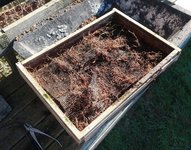Have you checked out the threads started by
@clem ?
He is using wide shallow boxes. His pace and results are excellent. Links below
In terms of materials, I have not found anything better than wood. It is as durable as we need it to be, and allows us to easily fasten nails or staples. I have used tile, plastic, etc. and did not like the fact that I could not use stables. On very young material I use plastic discs (I usually cut out the bottoms of cracked pots), but once there is a need to specify exactly where certain roots should be, wood becomes very practical.
I have also used wood circles in taller pots as opposed to shallow boxes (see 2nd image). I do this knowing that all of my roots are going to hook 90-degrees downward into the substrate. That doesn't bother me because that's the point where I am going to prune all of the roots back to when I repot anyways. I have seen good rapid root-growth with this strategy - as much as shallow boxes, I would say. Its also nice that they take up less space on the bench - I would recommend trying both shallow boxes and taller (as in regular size) pots
hello, here's a project for long time, with 5 trunks of Katsura. Never grown Katsura before but it looks good. I plan to let them grow so that the nebari will grow and fuse. I wish to have 70-80 cm high main trunk In the green house to protect it from the wind (i live near to the beach...

www.bonsainut.com
hello, here is another acer palmatum project : a deshojo that i bought 2 years ago. the tree in the nursery in september 2018 -> I bought it because of the nebari (from cutting) and the curve at the base of the trunk -> In march 2019 while repotting it -> In a woodbox to let it grow ->...

www.bonsainut.com
hello, here's another palmatum projet : a beni chidori from cutting. The tree is the nursery in september 2019 -> I bought it because of its curves in thr trunk and the nebari -> The tree during repotting in march 2019 -> November 2019 -> The tree today : i think i'll cut the straight...

www.bonsainut.com
I bought this palmatum in a nursery 3 years ago. here is the tree in november 2017-> In april 2018, i repot it in a large and flat woodbox + i cut the crown -> The Young leaves of the beni tsukasa cultivar -> In june of 2018 the summer growth starts -> August 2018 -> November 2018 ->...

www.bonsainut.com
www.bonsainut.com
www.bonsainut.com
www.bonsainut.com
www.bonsainut.com



